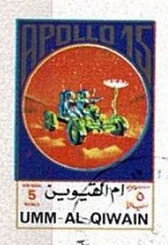Stamp: Apollo 15 (small size) (Umm al-Qiwain 1972)
Apollo 15 (small size) (Umm al-Qiwain 1972)
01 January (Umm al-Qiwain ) within release Apollo 11-17; small format goes into circulation Stamp Apollo 15 (small size) face value 5 Gulf naye paise
| Stamp Apollo 15 (small size) in catalogues | |
|---|---|
| Michel: | Mi: UM 934B |
| Colnect codes: | Col: UM 1972.00.00-212e |
Stamp is vertical format.
Perforation: type and size not mentioned by MichelAlso in the issue Apollo 11-17; small format:
- Mini Sheet - Apollo 11-17, moon surface face value 8*5;
- Mini Sheet - Apollo 11-17; small format face value 48;
- Stamp - Apollo 11 (small size) face value 5;
- Stamp - Apollo 12 (small size) face value 5;
- Stamp - Apollo 13 (small size) face value 5;
- Stamp - Apollo 14 (small size) face value 5;
- Stamp - Apollo 15 (small size) face value 5;
- Stamp - Apollo 16 (small size) face value 5;
- Stamp - Apollo 17 (small size) face value 5;
- Stamp - Map of the moon (small size) face value 5;
Stamp Apollo 15 (small size) it reflects the thematic directions:
The Moon is Earth's only natural satellite. It orbits at an average distance of 384,400 km (238,900 mi), about 30 times the diameter of Earth. Tidal forces between Earth and the Moon have over time synchronized the Moon's orbital period (lunar month) with its rotation period (lunar day) at 29.5 Earth days, causing the same side of the Moon to always face Earth. The Moon's gravitational pull – and to a lesser extent, the Sun's – are the main drivers of Earth's tides.
Outer space (or simply space) is the expanse that exists beyond Earth's atmosphere and between celestial bodies. It contains ultra-low levels of particle densities, constituting a near-perfect vacuum of predominantly hydrogen and helium plasma, permeated by electromagnetic radiation, cosmic rays, neutrinos, magnetic fields and dust. The baseline temperature of outer space, as set by the background radiation from the Big Bang, is 2.7 kelvins (−270 °C; −455 °F)
A vehicle (from Latin: vehiculum) is a mobile machine that transports people or cargo. Typical vehicles include wagons, bicycles, motor vehicles (motorcycles, trucks, buses), railed vehicles (trains, trams), watercraft (ships, boats), aircraft and spacecraft. Land vehicles are classified broadly by what is used to apply steering and drive forces against the ground: wheeled, tracked, railed or skied. ISO 3833-1977 is the standard, also internationally used in legislation, for road vehicles types, terms and definitions.




